Rehabilitation Program: Visual and Spatial Abilities
Click to try FREE for 15-Days.
This module contains 4 exercises designed to train visual and spatial abilities. It aims at training the patient’s visual mental imagery and more particularly mental rotation in a 3D space.

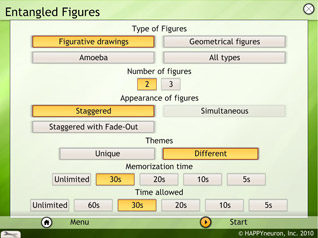

Entangled Figures
The task
In this task, the patient sees three entangled objects, which, taken together, make up a more complex figure. These three entangled graphical objects are compared to a multiple choice of similar or different objects that are possible components of the complex entangled figure. He must choose the ones that are part of the entangled figure. Identification is easier when the figures are meaningful (objects, geometrical figures), so details are more relevant than the analysis of the whole figure. However, recognition will be more difficult with abstract figures. Naturally, such a complex task takes great concentration.
What it trains
The exercise trains the user's visual and spatial skills and his working memory. Indeed, he has to identify the identifying characteristics of an object, store them in his working memory, and then transform the details into a whole by visualizing them in his mind and holding them. He must mentally disentangle the complex figure into its component parts. He also has to pay attention to details as they can help him distinguish the objects.
Parameters
The parameters that can be selected are the type of figure (figurative drawing, geometrical figure, amoeba, or all types), the number of figures (2 or 3), the appearance of figures (staggered, simultaneous, staggered with fade-out or all types), the theme of figures (unique or different), the memorization time (unlimited, 30, 20, 10, or 5 seconds,) and the time allowed to select the figures composing the entangled figure (unlimited, 60, 30, 20, 10, or 5 seconds). Five entangled figure are presented for each level.
Number of Unique Configurations
Over 1,000 unique game configurations and significant data set depth.


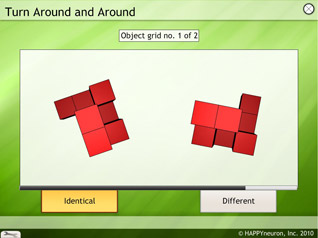
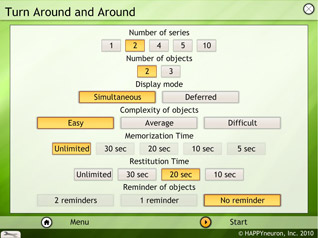
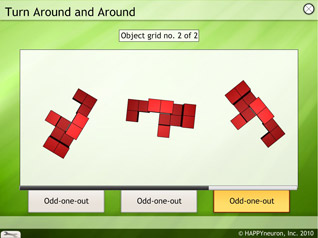
Turn Around and Around
The task
In this exercise, the aim is to determine if the 3-D geometrical figures presented to the subject from various angles are in fact the same or a different geometrical figure. The exercise is designed to strengthen your powers of visual mental imagery, and more particularly, mental rotation, which we use to recognize objects seen from unusual angles.
What it trains
Mental rotation is the ability to rotate mental representations of two-dimensional and three-dimensional objects and it is a skill we use daily. This task aims at training the patient's visual mental imagery and more particularly mental rotation. Indeed, he has to visualize elements in a pattern, identify surface patterns of 3-D objects and create a mental image of them, visualize their rotations, and make comparisons in order to decide whether the objects are the same or not.
Parameters
The parameters that can be selected are the number of series (1, 2, 4, 5, or 10), the number of objects (2 or 3), the 3-D object presentation (simultaneous or deferred), the complexity of the object (easy, medium, or hard), the memorization time (unlimited, 30, 20, or 10 seconds), the answer time (unlimited, 30, 20, 10, or 5 seconds), and the reminder of objects (2 reminders, 1 reminder, or no reminder).
Number of Unique Configurations
Over 2,600 unique game configurations and significant data set depth.


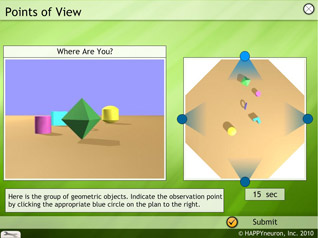
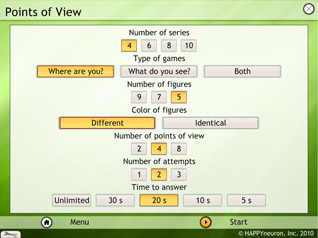
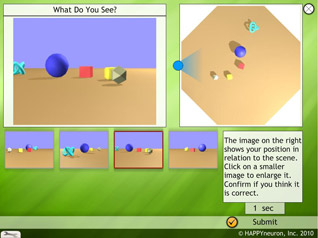
Points of View
The task
It is not always easy to mentally perceive the accurate 3-D spatial representation of a landscape from a map, or of a monument from a plan. In this exercise, the task is divided into two parts. In the first part, the patient has to deduce the location of an observer on a map based on what he sees. In the second part, he has to deduce what the observer sees based on his location on a map.
What it trains
Location, distance, direction, and perspective are characteristics of spatial orientation that affect how we gather, process, and express information. This exercise trains the subject's logical visual and spatial thinking since he has to mentally visualize different objects in a map from different points of view. He has to analyze the shape and the distance between the different elements and structure the space he is observing.
Parameters
The parameters that can be selected are the number of series (4, 6, 8, or 10), the type of game (Where are you?, What do you see, or both), the number of figures presented (5, 7, or 9), the color of figures (identical or different), the number of points of view (2, 4, or 6), the number of tries (1, 2, or 3), and the response time (unlimited, 30, 20, 10, or 5 seconds).
Number of Unique Configurations
Over 3,200 unique game configurations and significant data set depth.


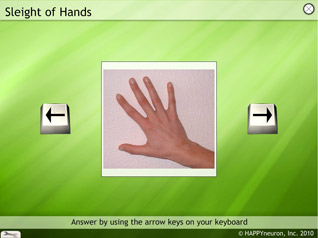
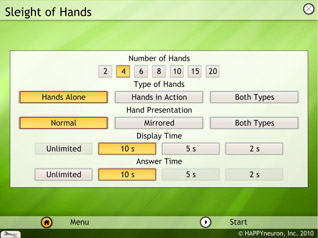
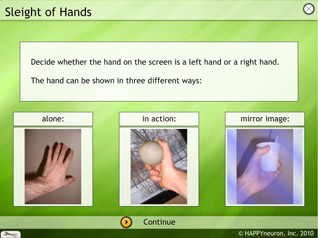
Sleight of Hands
The task
This exercise consists of deciding whether the hand which appears briefly on the screen is a left or a right hand. To provide varying degrees of challenges, the hand can be presented under different conditions: just the hand itself, the hand in action with an object, or a mirror image of the hand.
What it trains
Mental rotation, the main ability used in this exercise, usually takes place in the right cerebral hemisphere of the brain, more specifically, in the parietal regions where perception also occurs. Mental rotation comparison tasks can be analyzed into five steps: (1) create a mental image of an object, (2) rotate the object mentally until a comparison can be made, (3) make the comparison, (4) decide if the objects are the same or not and (5) report the decision.
Parameters
The parameters that can be selected are the number of hands (2, 4, 6, 8, 10, 15 or 20), the type of hands (alone, in action or both types), then hand presentation (normal, mirrored or both presentations), the display time (unlimited, 10, 5 or 2 seconds) and the answer time (unlimited, 10, 5 or 2 seconds).
Number of Unique Configurations
Over 600 unique game configurations and significant data set depth.


Click to try FREE for 15-Days.
